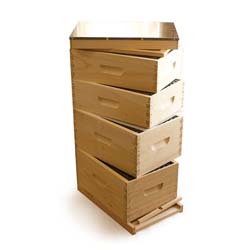Bees use cells within the hive to store pollen and nectar, but they also use them to raise future generations of the colony. The brood nest is the heartbeat of the hive. Without it, the colony wouldn’t survive. Within the brood nest, you’ll find worker, drone, or queen cells — and all stages of brood: egg, larva, and pupa. You can tell a lot about the health of your colony (and your queen) by examining the brood pattern.
A great brood pattern will be solid and compact with little empty space between cells. Most cells should be filled with developing brood at the same stage, especially capped worker brood.
You’ll typically see:
- Various stages of brood grouped by stage, indicating that the queen laid in a consistent, organized pattern.
- Very few skipped cells – some empty cells are normal for temperature regulation or emerging bees, but most should be occupied.
- Mostly worker brood, with limited drone brood on the outer edges or during certain seasons.
- Clean, well-capped cells, free of sunken, perforated, or discolored cappings.
A solid brood pattern usually means the colony has a healthy, well-mated queen and minimal stress, disease, or mite problems.
A bad brood pattern is usually scattered, uneven, and inconsistent. Instead of a solid patch, there will be empty or randomly placed cells with brood scattered throughout. This patchy appearance is often called a “shotgun pattern.”
Warning signs of a poor brood pattern include:
- Spotty coverage with lots of skipped or empty cells between brood.
- Multiple eggs per cell or eggs on cell walls – signs of a laying worker or failing queen.
- Domed (bullet-shaped) cappings, showing excessive drone brood in worker areas.
- Sunken, perforated, or discolored cappings, which can indicate brood disease such as chalkbrood or American foulbrood.
A bad brood pattern may suggest:
- A failing, poorly mated, or missing queen.
- High varroa mite loads, disease, or nutritional stress.
- Bees removing sick brood (hygienic behavior), pointing to underlying issues.
In summary, brood patterns tell beekeepers a lot about colony health. While it may seem overwhelming at first, learning to read your brood nest is one of the most valuable skills you can develop. If you notice signs of a bad pattern, it’s time to take a closer look – and possibly take action.
